Daan de Geus
How Important are Videos for Training Video LLMs?
Jun 07, 2025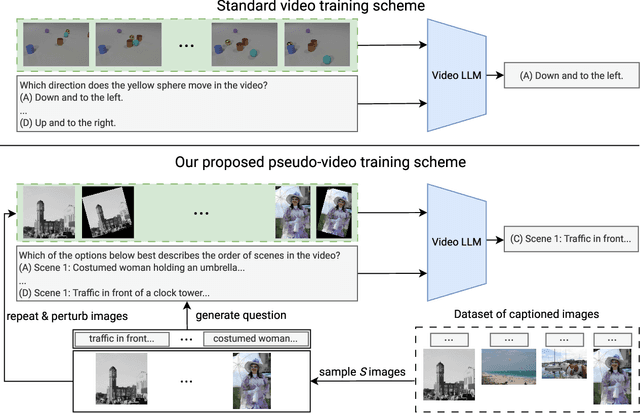
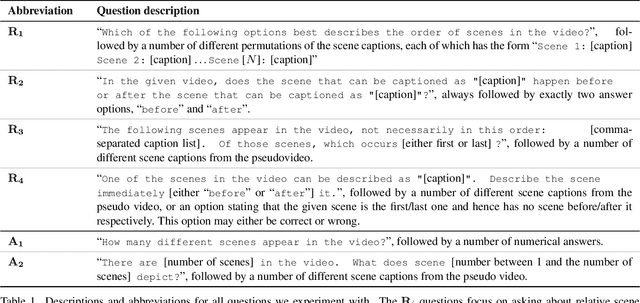
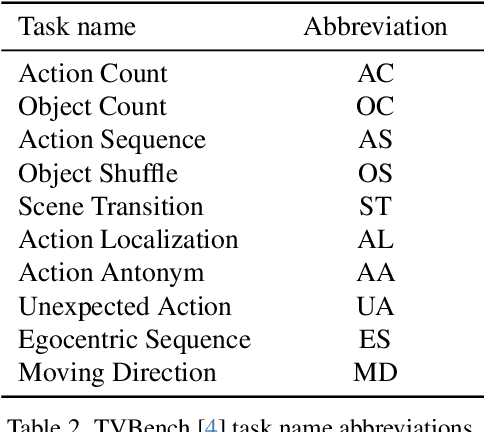
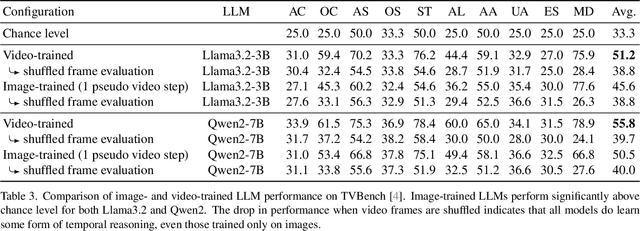
Abstract:Research into Video Large Language Models (LLMs) has progressed rapidly, with numerous models and benchmarks emerging in just a few years. Typically, these models are initialized with a pretrained text-only LLM and finetuned on both image- and video-caption datasets. In this paper, we present findings indicating that Video LLMs are more capable of temporal reasoning after image-only training than one would assume, and that improvements from video-specific training are surprisingly small. Specifically, we show that image-trained versions of two LLMs trained with the recent LongVU algorithm perform significantly above chance level on TVBench, a temporal reasoning benchmark. Additionally, we introduce a simple finetuning scheme involving sequences of annotated images and questions targeting temporal capabilities. This baseline results in temporal reasoning performance close to, and occasionally higher than, what is achieved by video-trained LLMs. This suggests suboptimal utilization of rich temporal features found in real video by current models. Our analysis motivates further research into the mechanisms that allow image-trained LLMs to perform temporal reasoning, as well as into the bottlenecks that render current video training schemes inefficient.
DONUT: A Decoder-Only Model for Trajectory Prediction
Jun 07, 2025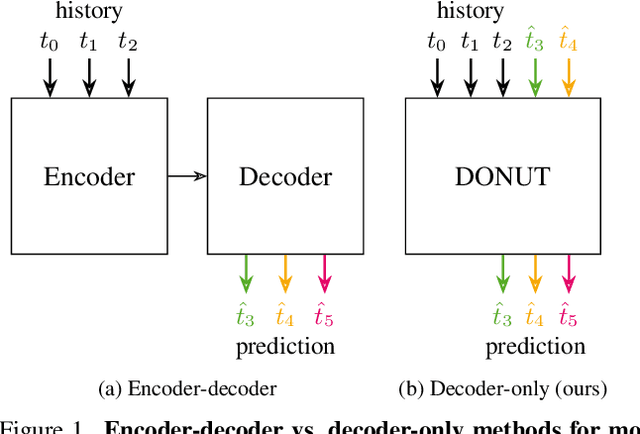


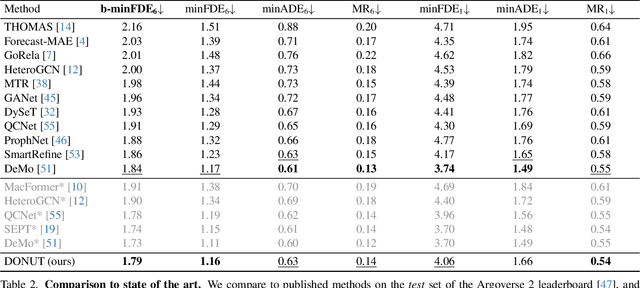
Abstract:Predicting the motion of other agents in a scene is highly relevant for autonomous driving, as it allows a self-driving car to anticipate. Inspired by the success of decoder-only models for language modeling, we propose DONUT, a Decoder-Only Network for Unrolling Trajectories. Different from existing encoder-decoder forecasting models, we encode historical trajectories and predict future trajectories with a single autoregressive model. This allows the model to make iterative predictions in a consistent manner, and ensures that the model is always provided with up-to-date information, enhancing the performance. Furthermore, inspired by multi-token prediction for language modeling, we introduce an 'overprediction' strategy that gives the network the auxiliary task of predicting trajectories at longer temporal horizons. This allows the model to better anticipate the future, and further improves the performance. With experiments, we demonstrate that our decoder-only approach outperforms the encoder-decoder baseline, and achieves new state-of-the-art results on the Argoverse 2 single-agent motion forecasting benchmark.
Your ViT is Secretly an Image Segmentation Model
Mar 24, 2025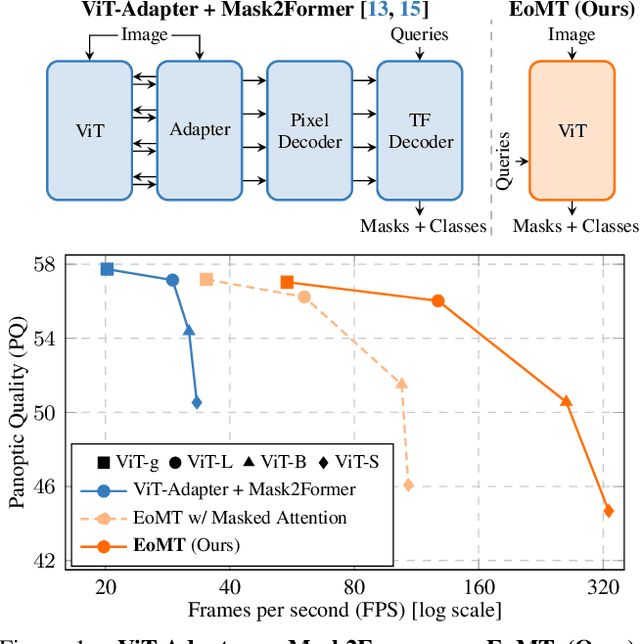
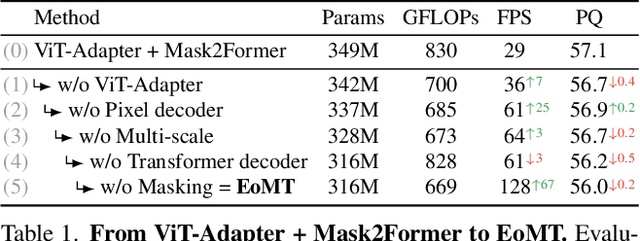
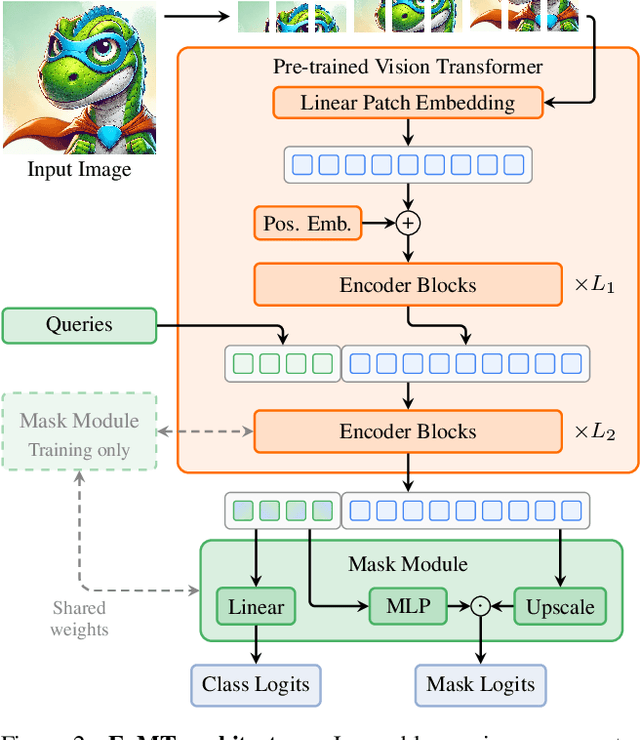
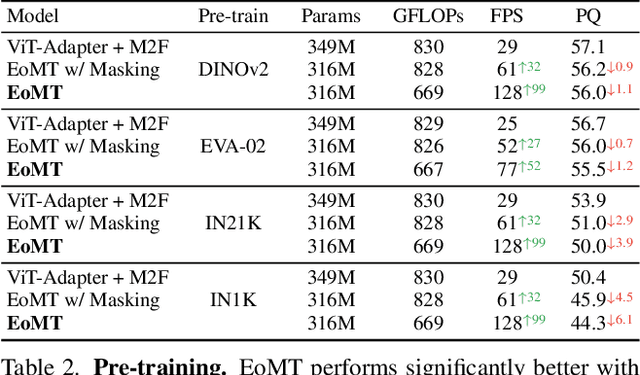
Abstract:Vision Transformers (ViTs) have shown remarkable performance and scalability across various computer vision tasks. To apply single-scale ViTs to image segmentation, existing methods adopt a convolutional adapter to generate multi-scale features, a pixel decoder to fuse these features, and a Transformer decoder that uses the fused features to make predictions. In this paper, we show that the inductive biases introduced by these task-specific components can instead be learned by the ViT itself, given sufficiently large models and extensive pre-training. Based on these findings, we introduce the Encoder-only Mask Transformer (EoMT), which repurposes the plain ViT architecture to conduct image segmentation. With large-scale models and pre-training, EoMT obtains a segmentation accuracy similar to state-of-the-art models that use task-specific components. At the same time, EoMT is significantly faster than these methods due to its architectural simplicity, e.g., up to 4x faster with ViT-L. Across a range of model sizes, EoMT demonstrates an optimal balance between segmentation accuracy and prediction speed, suggesting that compute resources are better spent on scaling the ViT itself rather than adding architectural complexity. Code: https://www.tue-mps.org/eomt/.
DINO in the Room: Leveraging 2D Foundation Models for 3D Segmentation
Mar 24, 2025Abstract:Vision foundation models (VFMs) trained on large-scale image datasets provide high-quality features that have significantly advanced 2D visual recognition. However, their potential in 3D vision remains largely untapped, despite the common availability of 2D images alongside 3D point cloud datasets. While significant research has been dedicated to 2D-3D fusion, recent state-of-the-art 3D methods predominantly focus on 3D data, leaving the integration of VFMs into 3D models underexplored. In this work, we challenge this trend by introducing DITR, a simple yet effective approach that extracts 2D foundation model features, projects them to 3D, and finally injects them into a 3D point cloud segmentation model. DITR achieves state-of-the-art results on both indoor and outdoor 3D semantic segmentation benchmarks. To enable the use of VFMs even when images are unavailable during inference, we further propose to distill 2D foundation models into a 3D backbone as a pretraining task. By initializing the 3D backbone with knowledge distilled from 2D VFMs, we create a strong basis for downstream 3D segmentation tasks, ultimately boosting performance across various datasets.
2024 BRAVO Challenge Track 1 1st Place Report: Evaluating Robustness of Vision Foundation Models for Semantic Segmentation
Sep 25, 2024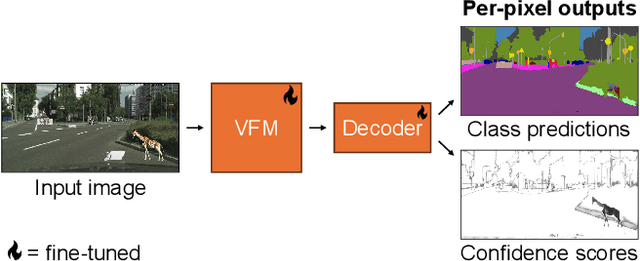



Abstract:In this report, we present our solution for Track 1 of the 2024 BRAVO Challenge, where a model is trained on Cityscapes and its robustness is evaluated on several out-of-distribution datasets. Our solution leverages the powerful representations learned by vision foundation models, by attaching a simple segmentation decoder to DINOv2 and fine-tuning the entire model. This approach outperforms more complex existing approaches, and achieves 1st place in the challenge. Our code is publicly available at https://github.com/tue-mps/benchmark-vfm-ss.
Fine-Tuning Image-Conditional Diffusion Models is Easier than You Think
Sep 17, 2024



Abstract:Recent work showed that large diffusion models can be reused as highly precise monocular depth estimators by casting depth estimation as an image-conditional image generation task. While the proposed model achieved state-of-the-art results, high computational demands due to multi-step inference limited its use in many scenarios. In this paper, we show that the perceived inefficiency was caused by a flaw in the inference pipeline that has so far gone unnoticed. The fixed model performs comparably to the best previously reported configuration while being more than 200$\times$ faster. To optimize for downstream task performance, we perform end-to-end fine-tuning on top of the single-step model with task-specific losses and get a deterministic model that outperforms all other diffusion-based depth and normal estimation models on common zero-shot benchmarks. We surprisingly find that this fine-tuning protocol also works directly on Stable Diffusion and achieves comparable performance to current state-of-the-art diffusion-based depth and normal estimation models, calling into question some of the conclusions drawn from prior works.
Exploring the Benefits of Vision Foundation Models for Unsupervised Domain Adaptation
Jun 17, 2024

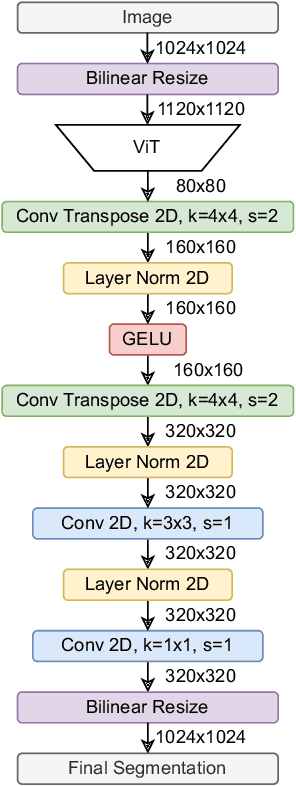

Abstract:Achieving robust generalization across diverse data domains remains a significant challenge in computer vision. This challenge is important in safety-critical applications, where deep-neural-network-based systems must perform reliably under various environmental conditions not seen during training. Our study investigates whether the generalization capabilities of Vision Foundation Models (VFMs) and Unsupervised Domain Adaptation (UDA) methods for the semantic segmentation task are complementary. Results show that combining VFMs with UDA has two main benefits: (a) it allows for better UDA performance while maintaining the out-of-distribution performance of VFMs, and (b) it makes certain time-consuming UDA components redundant, thus enabling significant inference speedups. Specifically, with equivalent model sizes, the resulting VFM-UDA method achieves an 8.4$\times$ speed increase over the prior non-VFM state of the art, while also improving performance by +1.2 mIoU in the UDA setting and by +6.1 mIoU in terms of out-of-distribution generalization. Moreover, when we use a VFM with 3.6$\times$ more parameters, the VFM-UDA approach maintains a 3.3$\times$ speed up, while improving the UDA performance by +3.1 mIoU and the out-of-distribution performance by +10.3 mIoU. These results underscore the significant benefits of combining VFMs with UDA, setting new standards and baselines for Unsupervised Domain Adaptation in semantic segmentation.
Task-aligned Part-aware Panoptic Segmentation through Joint Object-Part Representations
Jun 14, 2024Abstract:Part-aware panoptic segmentation (PPS) requires (a) that each foreground object and background region in an image is segmented and classified, and (b) that all parts within foreground objects are segmented, classified and linked to their parent object. Existing methods approach PPS by separately conducting object-level and part-level segmentation. However, their part-level predictions are not linked to individual parent objects. Therefore, their learning objective is not aligned with the PPS task objective, which harms the PPS performance. To solve this, and make more accurate PPS predictions, we propose Task-Aligned Part-aware Panoptic Segmentation (TAPPS). This method uses a set of shared queries to jointly predict (a) object-level segments, and (b) the part-level segments within those same objects. As a result, TAPPS learns to predict part-level segments that are linked to individual parent objects, aligning the learning objective with the task objective, and allowing TAPPS to leverage joint object-part representations. With experiments, we show that TAPPS considerably outperforms methods that predict objects and parts separately, and achieves new state-of-the-art PPS results.
ALGM: Adaptive Local-then-Global Token Merging for Efficient Semantic Segmentation with Plain Vision Transformers
Jun 14, 2024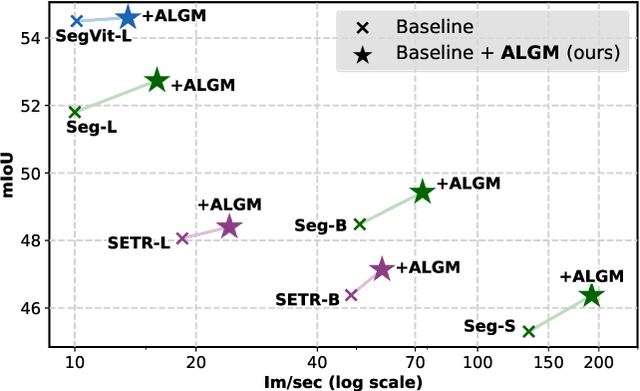
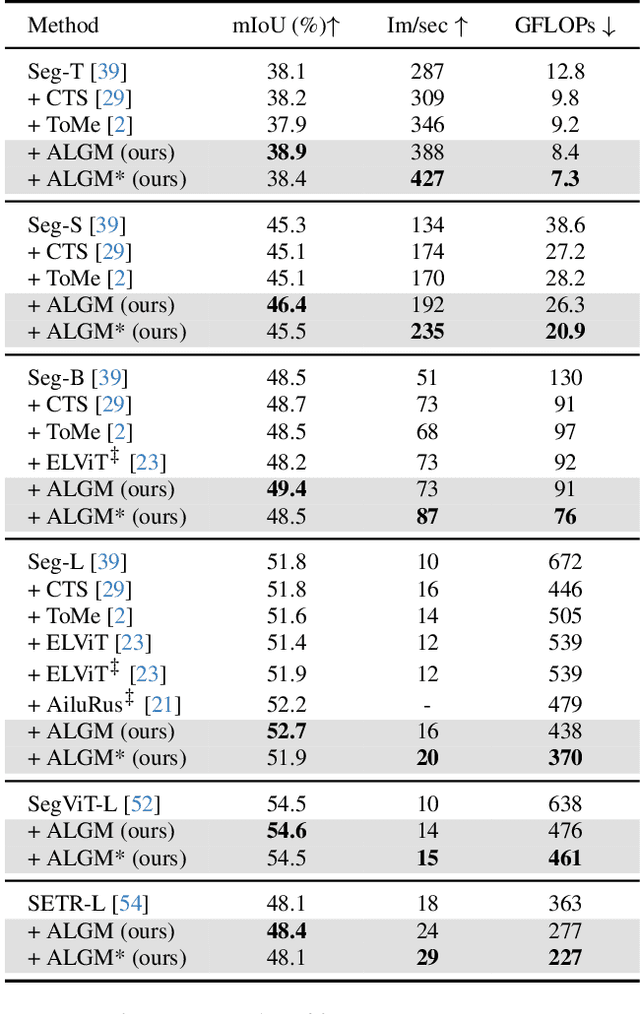
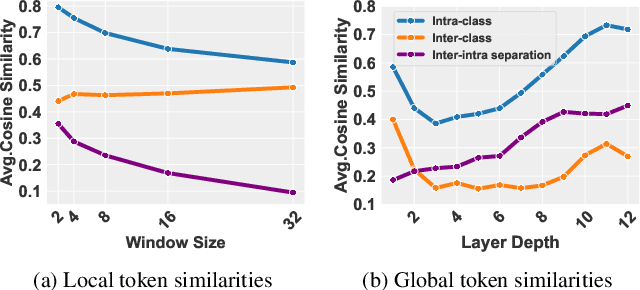

Abstract:This work presents Adaptive Local-then-Global Merging (ALGM), a token reduction method for semantic segmentation networks that use plain Vision Transformers. ALGM merges tokens in two stages: (1) In the first network layer, it merges similar tokens within a small local window and (2) halfway through the network, it merges similar tokens across the entire image. This is motivated by an analysis in which we found that, in those situations, tokens with a high cosine similarity can likely be merged without a drop in segmentation quality. With extensive experiments across multiple datasets and network configurations, we show that ALGM not only significantly improves the throughput by up to 100%, but can also enhance the mean IoU by up to +1.1, thereby achieving a better trade-off between segmentation quality and efficiency than existing methods. Moreover, our approach is adaptive during inference, meaning that the same model can be used for optimal efficiency or accuracy, depending on the application. Code is available at https://tue-mps.github.io/ALGM.
How to Benchmark Vision Foundation Models for Semantic Segmentation?
Apr 18, 2024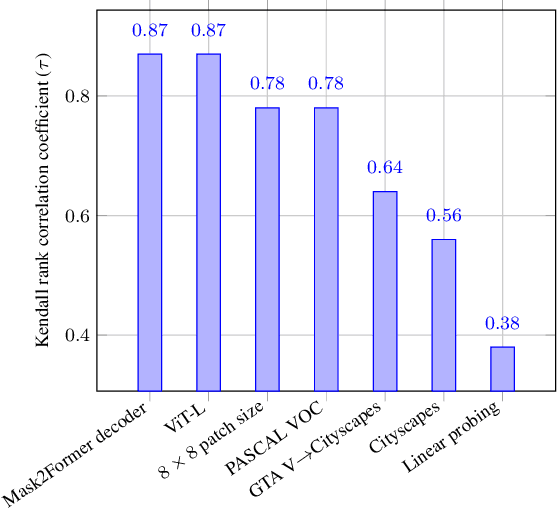


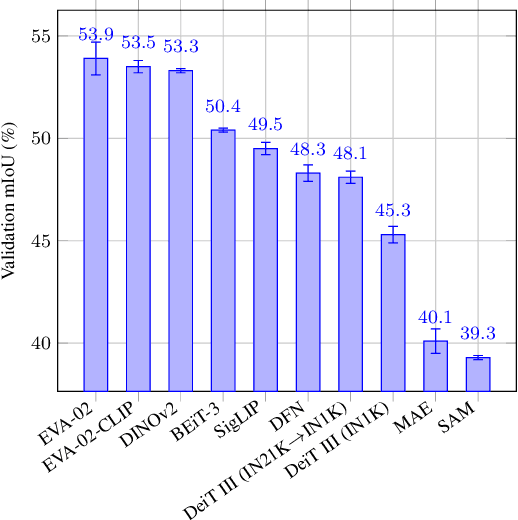
Abstract:Recent vision foundation models (VFMs) have demonstrated proficiency in various tasks but require supervised fine-tuning to perform the task of semantic segmentation effectively. Benchmarking their performance is essential for selecting current models and guiding future model developments for this task. The lack of a standardized benchmark complicates comparisons. Therefore, the primary objective of this paper is to study how VFMs should be benchmarked for semantic segmentation. To do so, various VFMs are fine-tuned under various settings, and the impact of individual settings on the performance ranking and training time is assessed. Based on the results, the recommendation is to fine-tune the ViT-B variants of VFMs with a 16x16 patch size and a linear decoder, as these settings are representative of using a larger model, more advanced decoder and smaller patch size, while reducing training time by more than 13 times. Using multiple datasets for training and evaluation is also recommended, as the performance ranking across datasets and domain shifts varies. Linear probing, a common practice for some VFMs, is not recommended, as it is not representative of end-to-end fine-tuning. The benchmarking setup recommended in this paper enables a performance analysis of VFMs for semantic segmentation. The findings of such an analysis reveal that pretraining with promptable segmentation is not beneficial, whereas masked image modeling (MIM) with abstract representations is crucial, even more important than the type of supervision used. The code for efficiently fine-tuning VFMs for semantic segmentation can be accessed through the project page at: https://tue-mps.github.io/benchmark-vfm-ss/.
 Add to Chrome
Add to Chrome Add to Firefox
Add to Firefox Add to Edge
Add to Edge